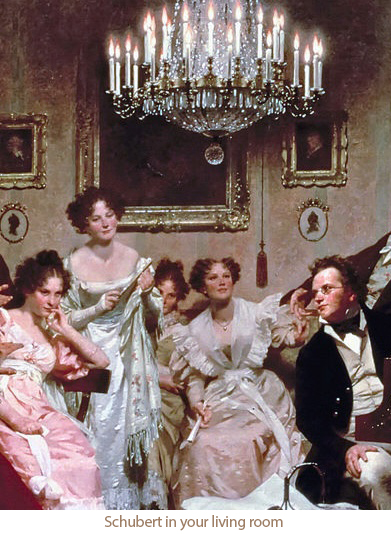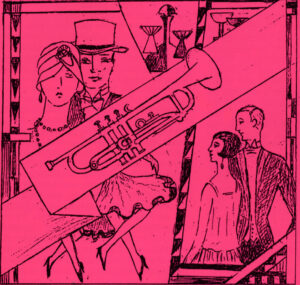
14. Inside Voice
One of my wife’s more spectacular communication achievements with our German Shorthaired Pointer Tesla was getting Tesla to understand the concept of ‘indoor voice.’ A big healthy and enthusiastic pointer has some serious vocal chops and is capable of telling you that she’s found a pheasant in a patch of grass many acres away. And, of course, we had no interest in discouraging her enthusiasm when she was inside the house. But still, when she barked, the notion of continuing a phone conversation was hopeless.
One day Tesla was inside barking at something outside — maybe a squirrel or a housebreaker — who knows, they would have gotten equal treatment, when Leanne quietly said to Tesla, “Ssh! Use your indoor voice.”
This stopped Tesla in her tracks. A new command, somehow related to barking. Tesla cocked her head, which meant, “Tell me more.” So Leanne explained and demonstrated. “Outdoor voice” followed by a big bark from Leanne, and then “indoor voice,” followed by a fine little demonstration of what an ideal dog might do if their IQ was around 132.
And the weird thing was, Tesla got it. Right away. And never forgot it. The command was especially useful in the car, as Tesla would struggle mightily to do what no other German Shorthaired Pointer had ever done before: mumble. A little like John Wayne walking away from a fight: “Why I oughtta….”
Which brings us to music that’s right-sized for your home. It’s called, chamber music, and it’s music you can live with, with some wine and cheese and even conversation. It’s not wallpaper, since much of what I’m going to suggest is some of the most gorgeous music that exists. But it’s almost always polite enough to share your space with you.
Chances are almost every composer you’ve tried by now has written some chamber music. That’s because composers often write for other musicians. As a composer, you don’t have to wait for an entire orchestra if you want to hear your chamber music — there are always a few musicians around who might want to come over and just play for fun. And that’s what chamber music is, pretty much. Pleasant. Something you can have in your house and easily get along with.
We’ve already looked at string quartets in another chapter (10. Albatrosses), so we’ll be talking about some of the other possible ensembles that typically play chamber music.
When Mozart was near the end and the peak of his short life, he had become close friends with the clarinetist Anton Stadler. Stadler had been experimenting with some new kinds of sounds a clarinet might produce, designing a clarinet which added new low notes never heard before, producing a voice that seemed to be closer to the human than had previously existed. Inspired by this wonderful sound, and Stadler’s musicianship, Mozart created the Clarinet Quintet (K. 581) for Stadler and a string quartet.
Now, before you run off and find a performance on YouTube, a word of caution. Yes, there are some good performances available (Sabine Meyer is right there) but there’s a big problem with the YouTube setting. They’re on a stage, in formal dress, surrounded by microphones and other clutter. Completely wrong for chamber music! They need to be in your living room, not on your screen. So please, if you have it on YouTube, turn off the picture. Or better yet, find a great recording and just put it on.
I could be wrong, but I have a feeling that the Germans created the word gemütlich specifically to describe the feeling of the Mozart’s Clarinet Quintet.
Now I’m going to send you on what I hope does not turn out to be a wild goose chase. One of my favorite recordings is something my youngest, Max and I found back in the old days when browsing was still alive. Tower Records in San Francisco had not only a Classical building all to itself, but they even had a small Classical Outlet shop far away in the Mission district. One lovely weekend we bicycled there and came back with a bunch of truly obscure recordings, each one of which has found a place in our hearts. Our chamber treasure has a purple cover with a 20s-ish style drawing and the title Kabinettstücke mit Trompete der ‘Zwansiger Jahre,’ ‘Chamber Music From the Golden Years’, which were the early 20s in Berlin. This is jazz-infused chamber music, still fresh and angular today, just full of delightful detail. If you search, you can find some used copies — on the FSM label number FCD 97 219. If you can’t find it, here are the three works on the CD: Martinu’s La Revue de Cuisine written for a ballet involving a whisk, a dish towel and other kitchen utensils; Poulenc’s Sonata for Horn, Trumpet and Trombone, and Alfredo Casella’s Serenade for Violin, Cello, Clarinet, Bassoon and Trumpet. If you can’t find the CD you put these together in a little playlist and re-create it.

If you’re beginning to get the feeling that there can often be a lot of fun in this intimate world of chamber music, try this: Darius Milhaud’s Octet (Opus 291), scored for two string quartets, is also, at the same time, his 14th and 15th string quartets. Just wrap your ears around that one. Imagine you’ve got two sets of string quartet players settled in your living room. One group plays a complete string quartet. Then the other group of four musicians play a completely different string quartet. Then they all play what they previously played, but now the two pieces of music are being played simultaneously. Chaos? No, perfectly integrated. Incredible.
It’s really kind of challenging if you want to try this. Just listen to each quartet a few times, to really get to know each of them, and then listen to the Octet in which they are layered together and try and pick out which stuff came from the 14th and which the 15th. I know this is pretty heady stuff for any animal, and probably for most humans, too. But it’s a brilliant challenge Milhaud set for himself, and both quartets stand pretty well on their own.
A foolish consistency is the hobgoblin of little minds, said Emerson, so I hope you’ll let me get away with recommending a video after having begged you not to watch a video of Mozart’s Clarinet Quintet. But this is a different kind of video and will probably tell you more about the joy of chamber music than you and your fleabitten one are likely to encounter otherwise. In light of the recent miraculous eight-hour Beatles Get Back, which gave us the privilege of watching genius at work, The Trout film captures five musicians in a moment in time before they’ve become world famous, as they work up a performance of a Schubert quintet. Here are Pinchas Zuckerman, for these purposes playing viola and about to become one of the world’s great violinists, Itzak Perlman, playing violin at the doorstep of a great career, Zubin Mehta, here playing double-bass and about to become one of the world’s great conductors, and the ill-fated lovers, Daniel Barenboim, pianist here and now pianist and conductor seemingly everywhere on earth at once, and Jacqueline du Pré, in her early twenties and not yet knowing she will be brought up short by Muscular Sclerosis.
It is a miracle that the film exists, that these about-to-be stars came together to play the Trout. It is free on YouTube and I hope it will be a delight for you and the young members of your family forever.
I want to suggest another one of those hard-to-find CDs that you can either buy on eBay or replicate into your own little playlist. This one we listen to every few months, around sunset, just as we’re putting together dinner. It’s sad and sweet, subtle and yet never tiring. Gabriel Fauré and his Grandpupils performed by the Esbjerg Ensemble and released on the TIM (The International Music Company) label. The three pieces are Fauré’s Piano Quartet No. 2, which is a piano and string quartet working together, Jean Françaix’s Octet for Wind Instruments and String Quartet, and Henri Dutilleux’s Les Citations.
You already know about a lot of the great string quartets from an earlier post, so you’ve already sampled some chamber music. Now you can add to your menu piano quintets (a string quartet with piano added) which have a lot of great music by most of the major 19th century composers, plus all kinds of other chamber groupings, found in duets and trios and somewhat larger ensembles. For trios, find anything by the Beaux Arts Trio, who recorded more than 60 albums over a period of almost 60 years, all gorgeous. Manahem Pressler, the pianist, founded the trio in 1955, and he is, I believe, still concertizing as a solo performer as he approaches 100 (this being written in 2022.)
One of my favorite pieces by Igor Stravinsky is for chamber orchestra — Dumbarton Oaks. For some reason which is beyond my understanding, there seem to be no limit on the number of recordings of this delicate flower of a piece in which the conductor seems to think it’s some sort of clockwork device and needs to sound like a ticking bomb. As I’ve suggested numerous times, with classical music, performance is everything. Get the wrong performance and that becomes your initial experience of the piece, you may miss what the composer had intended and a masterpiece could be forever lost to you. So take care to find, for instance, Christopher Hogwood’s performance (he’s the conductor) with the Saint Paul Chamber Orchestra. That will set the bar appropriately for you, and if you like the piece through Hogwood’s performance you’ll be prepared to make further discoveries of other performances and see which ones are keepers.
We’ll porbably do some additional posts on chamber works, since their place in music is so vast, but I would like to close with one more little masterpiece and hope that it might be one that connects with you. I missed hearing this until I was well into my fifties, and it has since become a regular when chamber music is called for. Written at the end of ghastly First World War, in 1919, it reflects the absolute emptiness that Edward Elgar must have felt when the slaughter had finally come to an end. The beginning is so tentative — it feels like a knock on a door of an abandoned cabin in the woods. It seems to ask, “After all this, is anyone there?” It may have influenced John William’s theme for Jaws a few decades later, since it has that same little musical idea that’s so easy to hum. But it’s used much more sparingly here, and then, following that mysterious little query, contrasts with a beautiful melody that attempts to restore our faith. Or something. These musings on what music might be saying are probably total hogwash — I’m just trying to convey my impression in the moment in the hope of piquing your interest at least enough to give it a listen.
Performances here, too, are really everything. I’ve searched for a lot of them and rarely find one that touches what the Medici String Quartet recorded with pianist John Bingham. We’ve found copies of this for all our kids, so maybe you can find one for yourself, or even find it streaming somewhere. I do see the CD still for sale on Amazon.
I hope you and your animal, and your kids, will find the Elgar Piano Quintet to be an ultimate indoor voice music, something in which every member of the family will find something of value.
